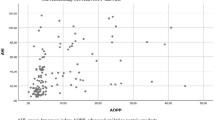Abstract
Study Objectives: Obstructive sleep apnea syndrome (OSA) is accompanied by oxygen desaturation and arousal from sleep. Free oxygen radicals are highly reactive molecules which could be produced by the OSA phenomenon of hypoxia/reoxygenation: cyclical alterations of arterial oxygen saturation with oxygen desaturation developing in response to apneas followed by resumption of oxygen saturation during hyperventilation. On the basis of these considerations, it was hypothesized that OSA may be linked to increased oxidative stress. Materials and methods: Twenty-six participants gave an interview during which a physician asked them about their age, smoking habits, and symptoms such as excessive daytime sleepiness and snoring. Physical examination and polysomnography were performed during their hospitalization. Reactive oxygen metabolites (ROMs) were measured in blood samples by the diacron reactive oxygen metabolites (D-ROM) test. Results: Twenty-one out of 26 subjects had an apnea/hypopnea index greater than 5 (OSA group). The measurement of free radicals was high in OSA patients. Furthermore, ROMs values in OSA patients were linearly correlated with the apnea/hypopnea index (R = 0.426; p = 0.042). The predictive value of a positive D-ROM test is 81%. Conclusions: ROMs were elevated in patients with OSA. When OSA was severe, similarly the value of ROMs in blood samples was enhanced, and the probable underlying mechanism for these events is the hypoxia/reoxygenation phenomenon.
Similar content being viewed by others
References
American Academy of Sleep Medicine Task Force. Sleep-related breathing disorders in adults: recommendations for syndrome definition and measurement techniques in clinical research. Sleep 1999;22:667–689
Pack AI. Obstructive sleep apnea. Adv Intern Med 1994;39:517–567
Halliwell B. Free radicals, antioxidants and human disease: curiosity, cause or consequence?. Lancet 1994;344:721–724
Halliwell B. The role of oxygen radicals in human disease with particular reference to the vascular system. Haemostasis 1993;23:118–126
Mugge A. The role of reactive oxygen species in atherosclerosis. Z Kardiol 1998;87:851–864
Shepard JW. Hypertension, cardiac arrhythmia, myocardial infarction and stroke in relation to obstructive sleep apnea. Clin Chest Med 1992;13:437–458
Dean RT, Wilcox I. Possible atherogenic effects of hypoxia during obstructive sleep apnea. Sleep 1993;16:S15–S22
Rechtschaffen A, Kales A. A Manual of Standardized Terminology: Techniques and Scoring System for Sleep Stages of Human Subjects. Los Angeles, CA: UCLA Brain Information Service/Brain Research Institute; 1968
Cesarone M, Belcaro G, Carratelli M, et al. A simple test to monitor oxidative stress. Int Angiol 1999;18:127–130
Schulz R, Mahmoudi S, Hattar K, et al. Enhanced release of superoxide from polymorphonuclear neutrophils in obstructive sleep apnea. Impact of continuous positive airway pressure therapy. Amer J Respir Crit Care Med 2000;162(2, pt 1):566–570
Halliwell B. The role of oxygen radicals in human disease with particular reference to the vascular system. Haemostasis 1993;23:118–126
Richards DCH, Jessup W, DeanRT. Cell surface proteins may be the primary targets during free radical-mediated cytolysis. Biochim Biophys Acta 1988;946:281–288
Vince GS, Dean RT. Is enhanced free radical flux associated with increased intracellular proteolysis?. FEBS Lett 1987;216:253–256
Cornelli U, Cornelli M, Terranova R. Free radicals and vascular disease. Int Union Angiol Bull 1999;15:7–10
Ray G, HusainSA. Role of lipids, lipoproteins and vitamins in women with breast cancer. Clin Biochem 2001 Feb;34:71–76
Trotti R, Carratelli M, Barbieri M. Performance and clinical application of a new, fast method for the detection of hydroperoxides in serum. Panminerva Med 2002;44:37–40
Iamele L, Fiocchi R, Vernocchi A. Evaluation of an automated spectrophotometric assay for reactive oxygen metabolites in serum. Clin Chem Lab Med 2002;40:673–676
Author information
Authors and Affiliations
Corresponding author
Rights and permissions
About this article
Cite this article
Christou, K., Markoulis, N., Moulas, A.N. et al. Reactive Oxygen Metabolites (ROMs) as an Index of Oxidative Stress in Obstructive Sleep Apnea Patients. Sleep Breath 7, 105–109 (2003). https://doi.org/10.1007/s11325-003-0105-9
Issue Date:
DOI: https://doi.org/10.1007/s11325-003-0105-9




